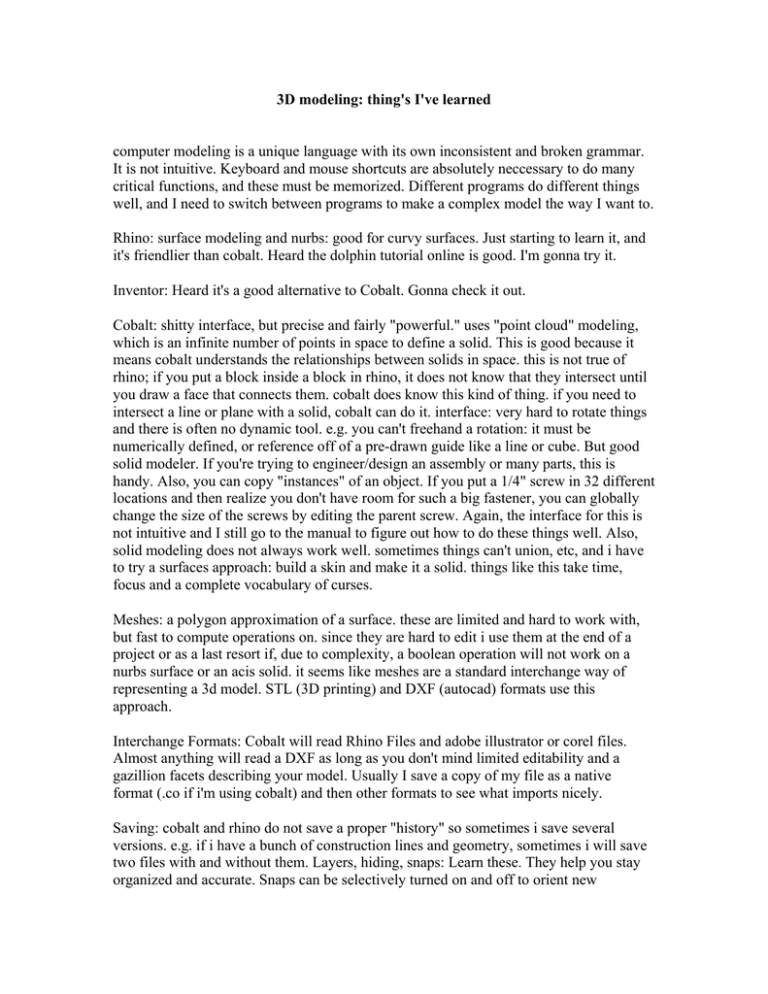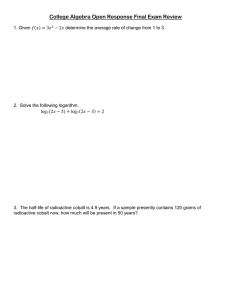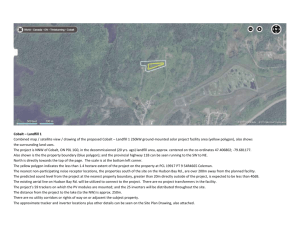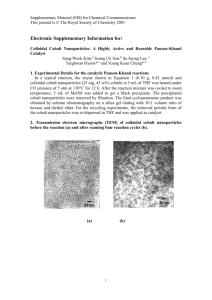3D modeling: thing's I've learned
advertisement

3D modeling: thing's I've learned computer modeling is a unique language with its own inconsistent and broken grammar. It is not intuitive. Keyboard and mouse shortcuts are absolutely neccessary to do many critical functions, and these must be memorized. Different programs do different things well, and I need to switch between programs to make a complex model the way I want to. Rhino: surface modeling and nurbs: good for curvy surfaces. Just starting to learn it, and it's friendlier than cobalt. Heard the dolphin tutorial online is good. I'm gonna try it. Inventor: Heard it's a good alternative to Cobalt. Gonna check it out. Cobalt: shitty interface, but precise and fairly "powerful." uses "point cloud" modeling, which is an infinite number of points in space to define a solid. This is good because it means cobalt understands the relationships between solids in space. this is not true of rhino; if you put a block inside a block in rhino, it does not know that they intersect until you draw a face that connects them. cobalt does know this kind of thing. if you need to intersect a line or plane with a solid, cobalt can do it. interface: very hard to rotate things and there is often no dynamic tool. e.g. you can't freehand a rotation: it must be numerically defined, or reference off of a pre-drawn guide like a line or cube. But good solid modeler. If you're trying to engineer/design an assembly or many parts, this is handy. Also, you can copy "instances" of an object. If you put a 1/4" screw in 32 different locations and then realize you don't have room for such a big fastener, you can globally change the size of the screws by editing the parent screw. Again, the interface for this is not intuitive and I still go to the manual to figure out how to do these things well. Also, solid modeling does not always work well. sometimes things can't union, etc, and i have to try a surfaces approach: build a skin and make it a solid. things like this take time, focus and a complete vocabulary of curses. Meshes: a polygon approximation of a surface. these are limited and hard to work with, but fast to compute operations on. since they are hard to edit i use them at the end of a project or as a last resort if, due to complexity, a boolean operation will not work on a nurbs surface or an acis solid. it seems like meshes are a standard interchange way of representing a 3d model. STL (3D printing) and DXF (autocad) formats use this approach. Interchange Formats: Cobalt will read Rhino Files and adobe illustrator or corel files. Almost anything will read a DXF as long as you don't mind limited editability and a gazillion facets describing your model. Usually I save a copy of my file as a native format (.co if i'm using cobalt) and then other formats to see what imports nicely. Saving: cobalt and rhino do not save a proper "history" so sometimes i save several versions. e.g. if i have a bunch of construction lines and geometry, sometimes i will save two files with and without them. Layers, hiding, snaps: Learn these. They help you stay organized and accurate. Snaps can be selectively turned on and off to orient new geometries to exiting ones. Layers are good. They allow you to group objects by categories (layers), and then selectively view/hide or edit/lock the layers. I usually put all of my construction lines on a layer and then turn off the layer when i need to see what my geometry looks like. "Folding": Let's say you want to make a pyramid out of paper. You might draw a bunch of triangles and tape them together and fold them up. Let's say you want to build a pyramid in rhino: you can take this approach. You draw the equilateral triangles all on the same plane and then create construction geometries to see where they intersect. The construction geometries are basically cones that describe the spatial sweep of the edges of the triangles as they fold through space. so maybe that gives some hints for creative ways to use guides and snaps. Good luck




